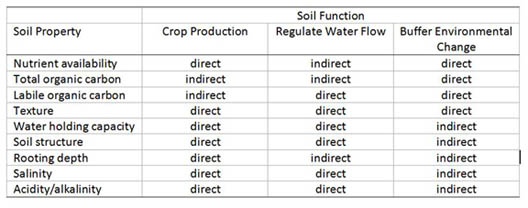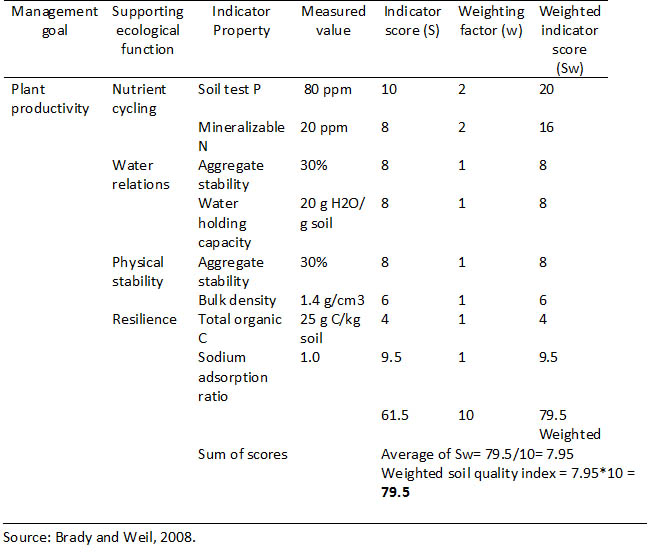- Return to Article Of The Month index
Managing Soil Quality for Pasture Sustainability
September, 2016
Maria Lucia Silveira, UF/IFAS Range Cattle Research and Education Center, Ona
Soils have been historically described and evaluated based on their ability to provide essential nutrients to plants. Terms such as “fertile”, “poor”, and “rich” have been frequently used to describe soil’s ability to sustain farming practices. For instance, an ideal “fertile” soil is often associated with soils that contain adequate amounts of nutrients for plant growth. Conversely, a less desirable, “poor” soil needs to be managed to achieve production of high-quality crop products. This is often accomplished by improving soil chemical characteristics, primarily through the use of fertilizers and liming materials.
During the last 50 years, significant scientific effort toward improving soil management was directed at developing soil test procedures and improving the availability of nutrients to sustain crop growth. Routine soil testing, for instance, was designed to identify nutrient deficiencies and inadequate soil pH conditions that may negatively affect crop production. It was also intended to determine nutrients that are present at adequate levels in the soil, providing an opportunity to eliminate unnecessary soil amendment applications. For decades, soil test reports have been used to predict the likelihood of obtaining a positive crop response from the application of the nutrient tested. However, despite the advantages of soil testing as a management tool in making fertilizer recommendations, traditional soil fertility assessments generally provide limited information regarding other important soil chemical, physical, and biological properties that can also impact crop performance.
Until recently, the importance of maintaining (or preferably increasing) soil organic matter was underestimated compared to the use of fertilizers and lime. This is partially due to the fact that limited tools are available to assess soil conditions other than routine soil testing. Research has demonstrated that soil organic matter can play an important role in determining the quality and performance of soils in many intensive agriculture systems (in many cases more so than routine soil testing alone). Land managers intuitively know that some fields perform better than others. Farmers often rely on visual assessment to judge the quality or condition of the field such as changes in soil color associated with organic matter accumulation or water accumulation, presence of invasive species, and crop performance. Research conducted by Gruver and Weil (2007) indicated a strong relationship between farmer’s perception of soil quality and soil carbon-related properties. This observation supports the idea that soil organic matter plays an integral role in the preservation of soil quality with subsequent positive impacts on crop production.
In addition to serving as the foundation of agriculture, soils can also support other important functions such as environmental protection, biodiversity habitat, water relations, and waste recycling. They also mediate many ecological processes that can have important direct impacts on the global water cycle and climate. In recent years, scientists and land managers have needed new tools that could provide an overall assessment of soil’s ability to perform multiple functions, including crop production. To address this holistic view of soil management, soil scientists developed the concept of “soil health” and “soil quality”. Although these terms are often used interchangeably, soil health describes the biological integrity of soil microbial community while soil quality refers to the ability of soils to support specific functions such as nutrient cycling, resilience and resistance, buffering filtering, and so forth. According to the USDA, National Resources and Conservation Service, soil quality is defined as the continued capacity of soil to function as a vital living ecosystem that sustains plants, animals, and humans. The Soil Science Society of America (SSSA) has defined soil quality as the capacity of a soil to function within ecosystem boundaries to sustain biological productivity, maintain environmental quality, and promote plant and animal health (SSSA, 2008). Therefore, based on both definitions of this concept, what constitutes a “good” or “bad” soil may depend on which goal, or intended use is under consideration. For instance, since soil quality is not limited to agriculture soils, an “ideal” soil intended to provide anchoring support for human structures may not be well suited for crop growth. In addition, by monitoring soil quality, land managers can better assess whether a set of management practices are sustainable.
Soil quality indicators
Indicators of soil quality provide information about how the soil is functioning with respect to the particular management goal or ecological role. Significant efforts are currently being placed on identifying soil properties for the determination of soil quality. Soil quality indicators may be qualitative (i.e., qualitative scorecards) or quantitative parameters and often includes three main categories of soil properties: chemical, physical, and biological. Ideal soil quality indicators should: 1. be easy to measure, 2. measure changes in soil functions, 3. encompass chemical, biological, and physical properties, 4. accessible to many users and applicable to field conditions, 5. sensitive to variations in climate and management.
Since a particular soil function may involve several processes, and each process may be associated with several soil chemical, physical, and biological property, the number of properties measured to assess soil quality may therefore be a dozen or more. As shown in Table 1, a number of soil properties may serve as indicators of soil quality. Some of these properties are descriptive and can be measured directly in the field. Others must be measured using laboratory analyses. Because some properties such as texture and soil depth are inherent of a particular soil type, they are not affected by soil management. Others, however, can be reversed and/or improved through the adoption of proper soil management strategies. Careful management of fertilizer and other soil amendments, addition of organic matter and manures, and proper stocking rates can improve soil quality and reduce the risks of soil degradation. Current research suggests that soil management can als/o lead to significant gains in crop yields while simultaneously protecting soil and water resources.
Table 1. Indicators of soil quality and related soil functions (Source: National Research Council, 1993).

Assessing soil quality
To provide an overall assessment of soil quality, researchers have developed a wide range of soil quality assessment methodologies. These often include a combination of physical, chemical, and biological properties such as soil organic matter, texture, water holding capacity, extractable essential nutrient concentrations, etc. Universal calibration of soil quality indicators is not possible, therefore, interpretation of soil quality assessments must rely on comparative data. Similarly, soil quality indicators will vary depending on the soil type, management goal, region, and cropping system.
Many soil properties that contribute to soil quality are interrelated. Thus, no single soil attribute can be used as a measure of soil quality. For instance, the soil quality index concept integrates a number of low-cost, easy to measure soil quality indicators to predict a soil’s ability to perform its primary functions. Each measured soil quality indicators is given a score which typically ranges from 0 (non-functioning) to 10 (optimal functioning). Because certain indicators have greater influence on the suitability of the soil to meet the management goal, each soil indicator score is then multiplied by an appropriate weight factor. Soil quality index is calculated by summing all the weighted scores.
The example below demonstrates how soil quality can be calculated:

Soil quality and sustainability
Recently, one of the main goals of soil quality concept is to guide soil management recommendations and the use of conservation practices. Since soil quality losses can potentially increase both environmental and production costs, soil managers are using soil quality as a means to examine the impacts of current practices and provide a framework for comparing management tradeoffs. For instance, current research has demonstrated that pasture management practices such as stocking rate, grazing method, and fertilization regimen can affect the amounts of soil organic matter, soil structure, and water and nutrient holding capacity. Therefore, using the concept of soil quality will provide land managers an aid in the development of management strategies that sustain production and yet protect soil and water quality. Soil quality assessment is a useful tool that can be used to compare soil quality from one soil to another.
Limitations
The great spatial variability associated with soil characteristics associated with the vast range of ecosystem types poses major limitations to the adoption of soil quality monitoring programs on a regional scale. Other major limitations include: lack of standard laboratory techniques, relatively high costs associated with laboratory analysis, and lack of coordinated efforts targeted at developing acceptable protocols and threshold levels for soil quality assessments.
In addition, economic factors may also limit the extent to which soil quality concepts can be adopted at a farm scale. From a land manager prospective, some management practices that could improve soil quality may not be considered feasible or economically sound. To date, our current economic system only rewards farmers for agricultural products they produce. However, there is a growing recognition that agriculture and, more specifically, soil management can provide much more than food, fuel, and fiber. Critically important ecosystem services offers a potential for society to recognize farmers and land managers for the true value they provide to society. Although economists are currently attempting to measure the economic benefit associated with conservation soil management, monetary income derived from ecosystem services is seldom available to incentivize adoption of appropriate soil management practices.
Despite the challenges and controversies, adoption of a system that measures changes in overall soil quality will be needed if conservation of soil quality becomes a major goal for natural resources management. Measurements of changes in soil quality over time can provide land managers with a useful tool to determine whether the practices being implemented are impacting positively (or negatively) the overall soil quality and potentially reduce the risk of soil and environmental degradation.
References
Brady, N.C. and R.R. Weil. 2008. Prospect for global soil quality as affected by human activities. Pp. 873-920. In: The nature and property of soils. Revised 14th. Pearson Education Inc., NJ.
Gruver, J.B., and R.R. Weil. 2007. Farmer perception of soil quality and their relationship to management-sensitive soil parameters. Renewable Agriculture and Food Systems, 22:271-281.
National Research Council. 1993. Monitoring and managing soil quality. p. 189-236. In: Soil and water quality: an agenda for agriculture. National Academic Press, Washington, DC.
Soil Science Society of America. 2008. Glossary of soil science terms. 1996. Soil Science Society of America Inc., Madison, WI, 82 p.
***
You are invited to join us by webinar on October 18, at noon, when Maria will present the information covered in this Ona Report and she will be available for questions. To participate this webinar you simply need to register online here: https://attendee.gotowebinar.com/register/5613575683952782593.

